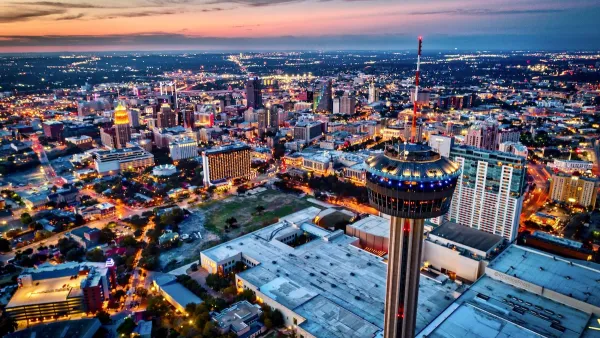When electricity was still in its infancy, municipal leaders turned to "moonlight towers" to provide mass illumination for their cities. Megan Garber explores the "brief and literally shining moment" in the history of electric streetlights.
"In the early years of electricity -- a time when steady illumination was new and expensive and unwieldy -- Americans knew one thing clearly: They wanted light, and lots of it, and as quickly as possible, please." Although grids of individual gas lamps provided a model for lighting urban areas, establishing a similar system of electric lamps provided safety and financial obstacles.
"City leaders, racing to bring their towns into the future and encouraged by electric companies seeking the same destination, tried to find better ways, cheaper ways, quicker ways to illuminate the American landscape," notes Garber. "And in their haste to vanquish nature by erasing the line between day and night, they ended up looking to nature as a guide. They looked up, seeking a model in the largest and most reliable source of nocturnal light they knew: the moon."
"And so, for a brief and literally shining moment early in the days of human-harnessed electricity, the future of municipal lighting was glowing orbs suspended high above cities -- towers, resembling oil derricks, capped with 4 to 6 arc lamps with a candlepower of 2,000 to 6,000 each. These manmade moons made the ultimate promise to the people below them: that they would never again be in the dark."
FULL STORY: Tower of Light: When Electricity Was New, People Used It to Mimic the Moon

Planetizen Federal Action Tracker
A weekly monitor of how Trump’s orders and actions are impacting planners and planning in America.

Chicago’s Ghost Rails
Just beneath the surface of the modern city lie the remnants of its expansive early 20th-century streetcar system.

San Antonio and Austin are Fusing Into one Massive Megaregion
The region spanning the two central Texas cities is growing fast, posing challenges for local infrastructure and water supplies.

Since Zion's Shuttles Went Electric “The Smog is Gone”
Visitors to Zion National Park can enjoy the canyon via the nation’s first fully electric park shuttle system.

Trump Distributing DOT Safety Funds at 1/10 Rate of Biden
Funds for Safe Streets and other transportation safety and equity programs are being held up by administrative reviews and conflicts with the Trump administration’s priorities.

German Cities Subsidize Taxis for Women Amid Wave of Violence
Free or low-cost taxi rides can help women navigate cities more safely, but critics say the programs don't address the root causes of violence against women.
Urban Design for Planners 1: Software Tools
This six-course series explores essential urban design concepts using open source software and equips planners with the tools they need to participate fully in the urban design process.
Planning for Universal Design
Learn the tools for implementing Universal Design in planning regulations.
planning NEXT
Appalachian Highlands Housing Partners
Mpact (founded as Rail~Volution)
City of Camden Redevelopment Agency
City of Astoria
City of Portland
City of Laramie


























